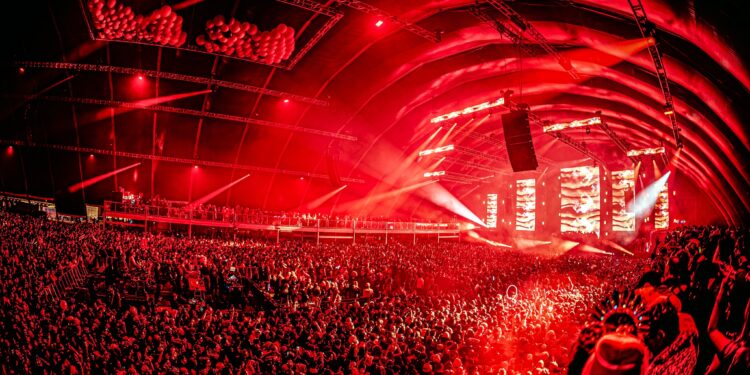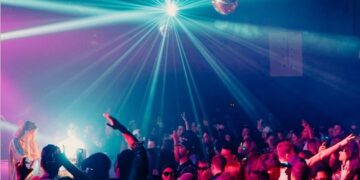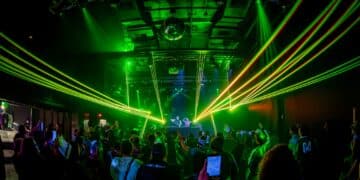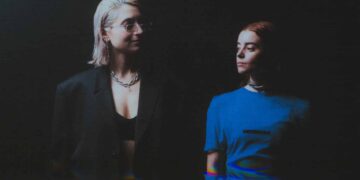Dreamstate: A word that might mean quite a lot of things to different people. Ecstasy, euphoria, an outer space journey, a trip down memory lane, being put in a state of trance. The list can go on and on. To help give you some context, I’ll try my best to explain what I think the word Dreamstate represents by reviewing’s Insomniac’s latest trance only festival: Dreamstate SoCal, which occurred over the course of the Thanksgiving weekend.
Trance-only festivals have been going on since the late 90’s across various parts of the world, mainly Western Europe. Thanks to events promoted by powerhouses such as Gatecrashers, ID&T’s Trance Energy and Sensation White, Tomorrowland, and many others, trance aficionados had plenty of choices to satisfy their needs for large scale, big sound and visual production events. With the rise of Armin’s A State of Trance, we’ve seen label driven smaller festivals touring all parts of the world. Events such as Subculture, Kearnage, Future Sound of Egypt, Pure Trance, and In Trance We Trust have filled a gap in between the large festival crowds and the small clubs by providing cutting edge music, great artist bookings, and some unique locations: boat cruises, ancient pyramids and ruins, large scale arenas and stadiums, and old 90’s rave warehouses. However, very few of such events have managed to penetrate the North American electronic music scene.
EDM and mainstream music dominate North American events. When Insomniac announced in mid-2015 that they’ll host the first ever trance only two-day festival, the tickets sold out in 24 hours and people hailed the bold move! Finally, they said, an event for trance fans that will rival what Europe has been putting together for ages! Since then, other Dreamstate events have been held in San Francisco (two-day), Mexico, Melbourne. EDC LV, NYC, Mexico, Orlando and UK have also hosted Dreamstate stages. With San Francisco and London already confirmed to host standalone events in 2017, the brand has expanded at a vertiginous pace.
The Thanksgiving show marked the first anniversary of the brand and a welcomed return to the sights of where it all began, the NOS Events Center in San Bernardino, Southern California. This was also the first show since San Francisco that was held over two days. Add a list of 65 of some of the best trance and psytrance DJs in the world spread across 4 different themed stages and you get, at least on paper, one heck of an experience! In practice, however, there were a few significant issues which lowered the overall experience on a personal level. I will use references from the previous shows in San Bernardino and San Francisco, both of which I attended, to compare the music, crowd, and audio/visual production quality.

Photo Credit: Insomniac Events
Artist Lineup
The first two shows I attended had a very simple format: one stage, 10 artists per day, 1 hour each. Easy to follow and to plan your schedule. I also felt that both times, we were given an excellent lineup. With the exception of three artists (out of a 40), I was keen on seeing everyone. I would call that a very high success rate. The music revolved around tech-trance, uplifting trance, psytrance and four progressive trance sets. It was clear that Dreamstate was supposed to be attended by fans of the higher BPM subgenres that stayed away from the commercial influences.
This time around, we were offered 65 artists on four different stages! Out of those, six were what I would deem new or local DJs. Five were commercial trance (big room and trouse). Three of them played progressive trance. The rest were quite the even split between psytrance, tech-trance, and uplifting. Many of the headliners in each genre had previously been booked for multiple Dreamstate events. This meant that even though I had 65 DJs on offer, I had a very easy time preparing my schedule. The only exception were the 11PM-1AM timeslots on Saturday, which is when ALL stages had headliners going against each other. Hence the tag line Conflictstate!
I have a huge love/hate relationship with multi-stage festivals. On the one hand, I love having a visual/audio experience. However, I also love being able to hear all the music that is played at an event. I usually go to any show from the opening beat until the last. This time, I felt ripped off since I could only witness 25% of the music on display. Also, I was not interested in many artists (either due to multiple bookings or not a fan of the artist). This only increased my irritation prior to the event as I felt I paid more money for less of the show.
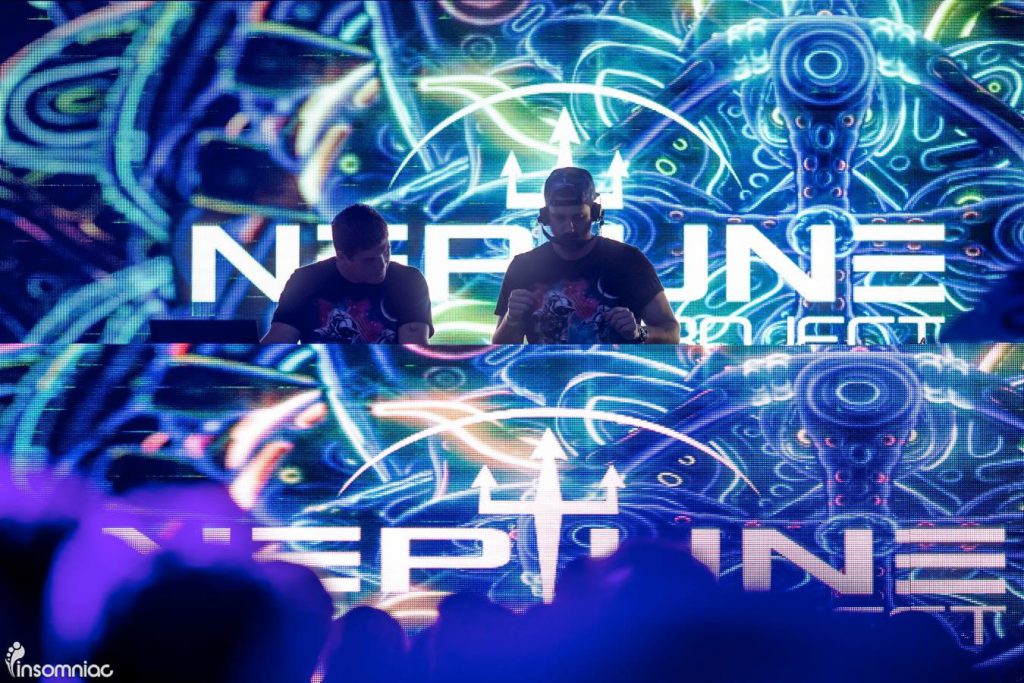
Photo Credit: Insomniac Events
Stages
I’ll break down this segment into three areas: stage design, audio, and visual. Outside of Magnus and PureNRG, I spent all my time on the Classics and Main stages. This means that some of the points I’ll highlight might not have been present throughout the entire event. I’ll speak separately about the Timeless stage as its purpose was very different from the rest.
Stage Design
There’s no way for me to sugarcoat this. All stages were disappointing, some more than others. Damus (the warehouse for the first Dreamstate event) was a very long and tall building. This allowed for the installation of a huge LED screen behind a big DJ booth. Bill Graham Center, the location for the San Francisco event, allowed for an even bigger screen. In contrast, all the screens this time around felt small. However, I liked the DJ booth on the Main stage and impressed by the one on Sequence. LED screens were installed on the entire booth and they synched up very well with the bigger screen at the back. The platforms also allowed for acrobats and dancers to perform, which was a very nice touch. In the grand scheme of things, I don’t put much value on the stage design itself. Regardless of whether the stage is big or small, I will not let it detract from the main reason why I’m at a show: THE MUSIC!
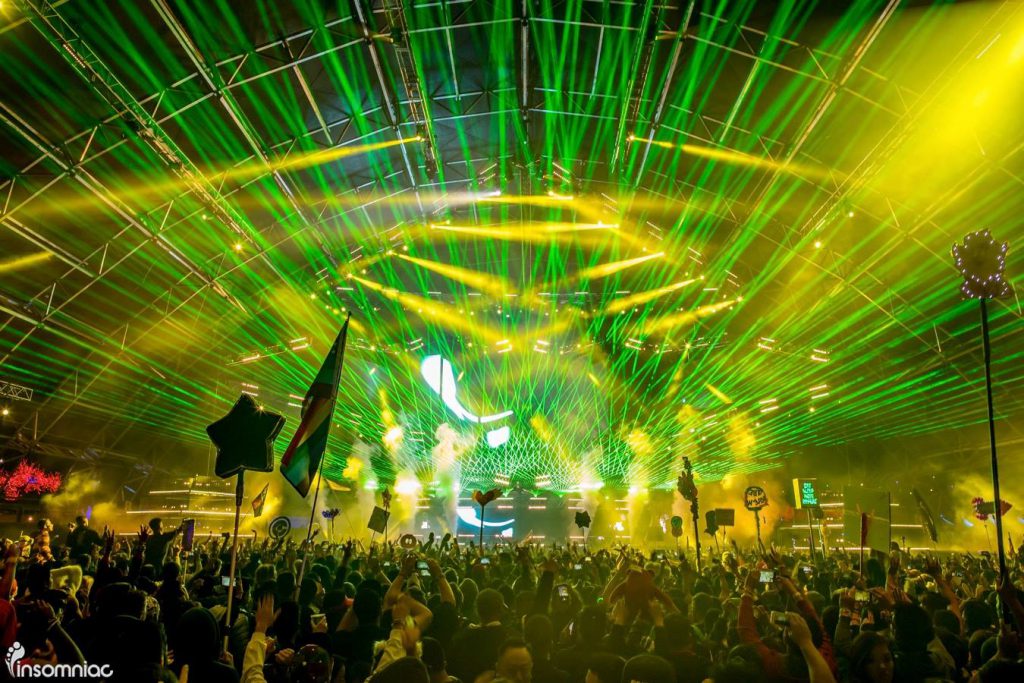
Photo Credit: Insomniac Events
Audio Design
This is the biggest issue I have with this event. The first Dreamstate SoCal took place in a warehouse. As such, it suffered severely from reverb and only at the back of the room was the sound manageable. The volume was also extremely high. When you struggle to distinguish the melody of a track due to the bass taking up the entire soundscape you know you have a problem. This was not only present during the psytrance sets (which are more focused around the lower frequencies). It was also featured in a few uplifting trance sets, predominantly the Aly & Fila and Standerwick sets. Over the course of recent years, white noise has become a must have for uplifting productions. I’m very much against this as it doesn’t make for a great listening experience if the sound system is off! In sharp contrast,
In sharp contrast, Bill Graham Center provided a wonderful experience for audiophiles. The building itself is host to many different types of live performances. Therefore, its design revolves around providing a clean and crisp sound. The sound fidelity was impressive, almost no reverb was present. The EQ was very good as well. Even though the show featured a few more psytrance sets, the issues experienced at the first event never showed up.
With such opposite experiences, I was skeptical of the sound design going into the San Bernardino event. Predominantly because we returned to the same location as the first one. While the stages were set up in different rooms, some problems persisted. For the entirety of Day 1, the sound volume was WAY too low. You could easily speak with people around you. The sound range also felt limited. The highs weren’t as high as they should be and the base was lacking some punch. There was also quite a significant volume variation depending on where you were situated on the dance floor. Part of this was due to my time being spent on outdoors stages, where it’s harder to get the sound balance perfect.
My only indoor set on Day 1 was PureNRG, which closed the Vision stage. Here as well, I found that the volume was a bit too low and most importantly, there was some reverb. It is important to note that I use high reduction ear plugs and that have an impact on the volume I perceive. However, at previous club and warehouses events, I never ran into a low volume problem while wearing them. Every time I can hear the crowd talk on top of the music I know that I won’t enjoy the night as much as I should be.
I’m happy to say that things improved for Day 2! The sound volume was a bit higher. This also meant that the sound distribution around the dancefloor was better. However, with outdoors stages, there’s so much you can achieve. My only set on the Sequence room was for Magnus. To my surprise, I found the audio experience to be the best of the entire weekend! Psytrance puts a huge emphasis on the low frequencies. However, Magnus combines baselines with exquisite melodies to give a vast sound bandwidth to his productions. The system was able to broadcast the entire range and it was very easy to hear every single detail. If only all the stages were set up this way!
Visuals
I have to start this segment by pointing out that Transmission has the best visual production out of all music events. It is the industry standard by which I always compare such large scale events. To give you a glimpse into Transmission, check this video:
[youtube https://www.youtube.com/watch?v=FqjQfEr9tjc]
Now that your eyes have adjusted to the laser bombardment, let’s continue! I never expected Dreamstate SoCal to be anything as grandiose as this. However, I want the same quality in the production. By that, I mean a choreography between the audio and visuals that enhances your experience. The first Dreamstate SoCal did a fabulous show of creating this. I was amazed at how well the visuals were in synch with the rhythm. You were told a story and it consisted of a pairing of sounds and lights. Each element complemented the other and was essential to the overall message. Breakdowns had minimal lights and no lasers. The buildups were a mix of lights and lasers, depending on the structure what type of elements the track contained. Percussion was paired with the lights. High hats and other FXs were tied to the lasers. And as the drop hit, everything was on display in perfect unity. It really was something beautiful to witness and it greatly enhanced the experience.
For the San Francisco event, things weren’t as amazing. That is because the Bill Graham Center is more a square than a rectangle. From past experiences, the longer the room, the better the laser effects. Another advantage of a rectangle is that you can create a sense of direction by using suspended lights that flow towards the rear of the room. In terms of actual production quality, I felt that things were just as good.
It is with much disappointment that I have to say that things took a turn for the worse this time. All big stages were shorter and not as wide. The lasers were fewer. The suspended lights had less intricate design patterns. While I understand that setting up multiple stages is expensive, it genuinely felt like a step down from past shows. Even the audio/visual synch seemed half a beat off. Combined with all the issues mentioned above the presentation side of things was quite the letdown.

Timeless Stage
I’ve decided to review this stage all by itself because it’s aim was different. DJ sets were predominantly two hours instead of one, at least for the main acts. The booth was very small and so was the dance floor. I estimate the capacity at fifteen hundred people at most. The other stages were a good four thousand. The lights setup was minimal and there were no lasers. And while this was never pushed as a Classics stage, the artists that were booked played them. Put everything together and you end up with an attempt at recreating the magic of Luminosity Beach Festival within a Dreamstate setting.
And for the most part, that was achieved! At least in terms of vibe, atmosphere, and music. The volume for Day 1 was very low. You had to be quite close to the speakers to enjoy the full power. Anywhere further back than 50ft, you would sense a significant drop. The quality was left to be desired as well. There was not a lot of reverb, but the sound was muffled and muddy. Things were improved for Day 2 but I was still not fully satisfied. The lack of lasers and minimal lights were welcomed actually. Luminosity has always been about creating a sense of connectedness between the DJ and the dancefloor. That is achieved by putting an emphasis on the music and the closeness of the DJ to the fans. It felt a lot more like a boat cruise or a house party instead of a big festival. And it was here that I found my place for the majority of the time.
Crowd
Festival crowds are always interesting to read. You have people that come to for the music. Others come for the experience. You have die-hard fans of certain artists. Others want to explore. You might dance next to an old raver, or a seasoned club goer, or someone that’s experiencing a music event for the first time. Everyone is part of a giant melting pot. And this in itself is very fun to see. I must confess though that I’m not super keen on dressing up (or down in some cases), socialising, or missing out on music to catch up with friends. I’ve got nothing against people that do it and it certainly doesn’t bother me. It’s simply something that I don’t partake in. I’m all in for socialising once the music stops.
Whenever I’m at a show, I dedicate my full attention to the musical journey that’s created in front of me. After listening to trance for close to 20 years, you come to know the intricate details of productions. You recollect certain tracks and how they flow. Sometimes, you can predict what comes next in the song. Other times, you remember under what circumstances you first heard a production. It’s these type of experiences that I simply love having. It is also why I mainly enjoy club and warehouse shows a lot more. You are surrounded by people that yearn for the same thing. I’m not saying that this wasn’t the case at Dreamstate SoCal, or that everyone should experience music in this fashion. Only that this is how I judge if a crowd is into the music that the DJ is offering us.
One negative thing I do want to point out is the following. I’m not expecting people to last the entire night and keep on dancing. However, if you do need a break, please don’t just sit down in the middle of the crowd. To me, that’s both disrespectful to the people around you and more importantly, the DJ! The main reason most of us attend shows is to dance to the music that we love. Constantly having to look out and avoid stepping on people is a hassle I don’t want to deal with.
For the most part, however, the crowd was fantastic. People that were on the Timeless stage were very knowledgeable. There were constant sing-alongs to classics and humming of melodies. For certain portions of the night, I did feel like I was at a small event. That for me shows the presence of this invisible link between the crowd, DJ, and the music. On the other hand, the crowds at the other stages were typical of festivals. Loud, compact, energetic. Less hypnotic and more active. And that was perfect given the setting.
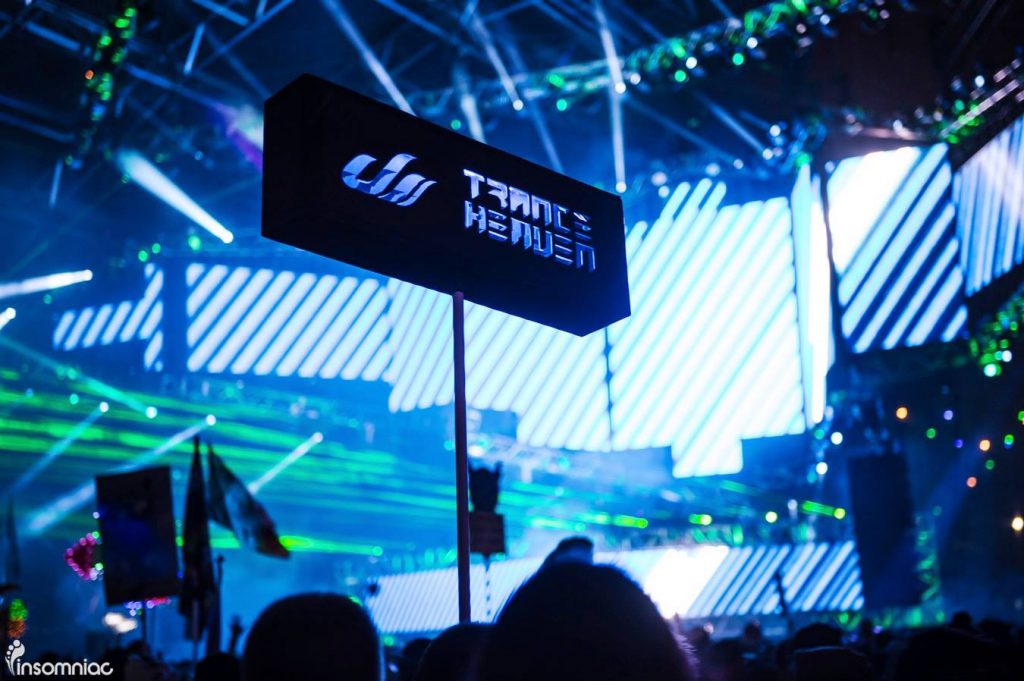
Photo Credit: Insomniac Events
Music
I’ve left the best portion for last, and with good reason. The music that I’ve heard saved the event for me. Even for 60-minute sets, I always prefer to see the full set. For me, jumping from one DJ to another every 15 minutes just to catch a couple of tracks is pointless. The musical journey is much more important and that requires hearing the complete set. For the majority of both days, I hung around the Timeless stage. For me, trance is all about emotions and melodies. The artists featured on this stage played, for the most part, exactly my type of sound.
Day 1
Neptune Project
This marked the 3rd time in 14 days that I saw Neptune Project. Under those circumstances, you’d normally hear the same tracks every single time. However, one of the main reasons why I love their sets is exactly because they bring enough variation in their track selection to make each set worth a listen. Or two. Or keep them on repeat at times :). Their two-hour mix consisted of numerous classics that almost no one else plays. Hearing M.I.K.E. – Universal Nation or Binary Finary – 1998 is great, but those are tracks mixed by almost every DJ. I’ll take a set that features Onova – Platitude and L.S.G. – Netherworld every single day of the week. The beauty of classics is that the number of high-quality productions is immense. A great DJ can make a 3-hour set and not play one known track. Yet the trance vibe would still be present. In my opinion, that’s not something that’s doable with today’s music. Neptune Project intertwines the classics with a select number of new productions to form one persistent sound in their mixes. To the ears of a new trance listener, distinguishing between the old and the new would be very difficult. It is for skills like these that I attend shows and I’ve always been impressed by every set from these guys.
This set had an added element that made it special for me. Neptune Project is a duo. As such, it’s rare that both guys are behind the decks. However, this marked the first show they did together in the US since Dreamstate San Francisco. It also was the first festival since the launch of their new platform, Amplifyd. While still in its infancy, Neptune Project fans have been extremely supportive. The number of branded shirts was overwhelming. The crowd support and acknowledgement of their music was also a joy to witness.
[youtube https://www.youtube.com/watch?v=TLsaKqeo9FA]
The Thrillseekers
Steve Helstrip is the man behind one of the cornerstone acts of trance. Since 1998, he has been producing music of an incredibly high quality. Surprisingly, however, he never released an album throughout his entire career. That is until the week after Dreamstate! For those wondering, Escape has been in the making for 10 years. His two-hour set was in part an album showcase. I say in part because just like Neptune Project, Thrillseekers sets are filled with classics. With a back catalogue that can rival any other producer, you can always expect a unique musical experience. A foray of soothing, dreamy, euphoric, warm sounds is how I would describe this set. The first thoughts when hearing the music is not to dance. Instead, you start contemplating about past experiences and memories. You live a rollercoaster of emotions. Melancholic melodies make you feel sad. Piano riffs make you feel happy. Supersaws give you the necessary energy to dance. This masterfully crafted two-hour journey perfectly explained the essence of trance. And for this very reason, this was of the highlights of the event for me.
Binary Finary
If you’re ever searching for a one hit wonder trance artist, look no further than Binary Finary. Their single 1998 took the entire scene by storm and launched them to superstar heights. Over the years, the track became one of the most remixed, most played, and most recognised pieces of music in the history of the genre. While they’ve created other songs over the course of the years, nothing ever came close to 1998. As DJs, they’ve always kept the classic vibe while also playing some newer remixes of tracks of old.
The first part of the set was a great mixture of classics in their full original glory and a few modern remixes. I tend to shy away from these modern remixes as they take away many elements that make the tracks unique and replace them by updated elements that are used in the majority of the tracks produced nowadays. However, two remixes, in particular, stood out for me in this set. Lost Tribe – Gamemaster (Dreamy 2014 Rework) and Paul Van Dyk – For An Angel (Oxygen remix). Both of these tracks bring a refreshing take on the original while also maintaining the heart and soul of the track.
The crown jewel of this set, however, were the last 35 minutes. We were treated to a wrath of Hard Trance classics, some of which I have not heard live in years! With the subgenre virtually dead nowadays, it was incredible to hear some of my favourite tracks ever live.
[youtube https://www.youtube.com/watch?v=kug-MVceOkg]
Pure NRG
Solarstone and Giuseppe Ottaviani have teamed up for what I deem to be the best-performing duo in our scene. Their approach is very simple. Do a selected number of events per year, create new music for them, and play as many of the elements of possible live! I’ve listened to all their sets (only a handful it must be said) and every single time I was in awe. It’s no surprise that PureNRG were closing day one on the Vision stage. I’ve spoken with quite a few people that attended this set and they claimed the set was average. My opinion couldn’t be further apart!
This set featured 10 tracks. Out of those, only one is an actual release. There were two new originals and remixes of Michael Jackson, Queen, Royskopp and Opus III. In other words, a trance set featured pop, rock, electronica, and dance music. In a 60 minute set, this looks like a melting pot of musical genres with zero cohesion. Understanding how to combine all these different sounds is no small feat. However, all I heard was a brilliant display of musical theory. This being a live performance helped with the flow of the set. You could hear as the drums were created, the main lead fading out and reappearing much later. The songs felt alive and organic, not made up of eight repeating bars to form an intro and outro. A set long groove and sound design was present and this helped bridge the gap between the various genres. It gave the set a central pillar around which these very different melodies were constructed. For someone like myself that appreciates the finer details, this was a masterclass in music creation. It should come as no surprise then that this was my favourite set of the day.

Day 2
Magnus
Magnus is an extraordinary producer that has been making music for close to 10 years yet very few people know about him. His signature sound consists of psytrance baseline (without any swing, triplets, breaks or other elements that are featured in the commercial psytrance productions) and some of the tranciest melodies in recent history. If the name might sound familiar, it’s because of his collab with Simon Patterson earlier in the year called Evoke! It sets him apart from any other producer and for this reason he’s one of my favourites.
With a slot of 6 PM, it wasn’t the best time to get into a psytrance, high energy set. However, that is exactly what happened! These 60 minutes featured a plethora of new material. The combination of hypnotic riffs and relentless and driving baselines worked flawlessly. There was very little time to recover your breath throughout the set. This to me is the essence of psytrance. It’s not about hands in the air moments, or singalongs or breakdowns. Its intent is much more simple. Break you down physically by its energy and also break you down mentally by its hypnotic nature. I’ve done 10-12 hours raves in the past without a sweat, but after these 60 minutes, I was ready for a slight break!
[youtube https://www.youtube.com/watch?v=P_FU6Ue_-nc]
Richard Durand
Tiesto at his peak played at the Olympics in 2004. No one else in the entire electronic music scene, not just trance, has come close to emulate. For millions of people, his compilation series In Search of Sunrise was the gateway to trance. It comes as no surprise then that an ISOS set will be an incredible occasion for many people to reconnect with those memories.
The ISOS CD mixes always had fantastic progression and this set replicated it. A slow start followed by ups and downs marked the first hour. Crowd favourite singalongs and riffs were a constant presence. Looking at many people in the crowd you realised how much this music meant to them. They seemed lost in their thoughts and memories, thrown back to various moments of their lives. The second portion actually brought it down even further before closing with an energetic 30 minutes. I was pleasantly surprised by this tempo change as very few DJs master the art of slowing down the pace of a set. It’s a double edged knife. Done wrong, it can kill the entire energy of the crowd. Performed well, it can create a unique experience. My only negative about this set was Richard’s transitions. While I loved the flow, for the lack of a better word, some transitions were butchered. Also, the constant mic talk was a distraction.
Talla 2XLC
I wasn’t fully engaged into this set for reasons not at linked to the music. I took the time to relax and talk to some friends. The actual set, from what I can remember was quite good. I’ve always loved the old Talla sound. I particularly enjoy his reworks of non-trance productions but I find his original works just good, nothing more. In particular, his reworks of Alan Walker feat. Iselin Solheim – Faded, Zombie Nation – Kernkraft 400 and Darude – Sandstorm were some of the best moments. It’s incredible how one track can change the dancefloor. Even to this day, Sandstorm remains THE electronic music party track. You can have an empty dance floor with people resting on couches or at the bar and the moment the riff is played, everyone flocks back! My favourite thing about this set though was hearing Fieldwork – This Is Not The End (Talla 2XLC138 Rework). The original is a lovely piece of melancholic chillout music and also the main theme of the movie Edge of Tomorrow.

Thomas Datt
Thomas is yet another highly skilled, yet barely known artist in the trance scene. Probably because he takes his time to release quality material instead and he rarely DJs. And by know, it should come as no surprise that these are exactly some the qualities I look for in my favourite artists. Thomas has been around since 2004 and has put out two artist albums. The first is quintessentially trance while the second one is what he likes to call Chilled Datt. In other words, it’s the equivalent of his trance tracks but stripped out of beats. He has also done a great number of remixes of non-trance tracks that have never been released. This means that his sets are filled with unique material that you won’t be able to hear anywhere else.
I can go into a very long and detailed analysis of this set, but the gist of it is this. Putting all bias for other DJs aside, it’s almost impossible to create a better 60 minute set than this! A special intro of Vantage – Dat Boi marked the start of a voyage through the very fabrics of space and time. Rarely have I felt teleported into a world where sound is the only sense at work. Vocals, chops, and eerie voices combined with hypnotic melodies, melancholic piano pieces, groovy baselines, and wicked acid lines formed the basis of this experiment. I felt like I was constantly floating in space and the sound frequencies were both the source and purpose of my movement. And before you ask, no drugs were needed. This to me represents the real power of trance. It is able to take you on an unforgettable journey all by itself. A journey that as much as you try to explain, it can only be understood by those that undertook it.
[youtube https://www.youtube.com/watch?v=_UmVZCAUdSw]
Paul Van Dyk
This was the second time in two weeks that I had seen Paul. The previous show was his much-anticipated return to New York, and you can find my review HERE. On the surface, this set looked like a simplified version of his previous show. Take out the classics, play fewer tracks, and voila. To the contrary, this set showed exactly why I still deem Paul to STILL be the best trance DJ alive!
The tracklist in itself was quite predictable, especially for someone like me that listens to Paul’s mixes on a regular basis. However, this show was all about the incredible transitions and the live elements. Hearing that signature high hat in a different song. Getting teased by that PVD kick as the transition commences. Listening to the melody from For An Angel being played live and changing three octaves! These are the elements that make Paul stand out head and shoulders above everyone. Paul no longer plays at 145-148BPM, something he used to do throughout the 1998-2006 period. Nowadays, he sticks to a constant 140. Nevertheless, the energy level reminded me of his closing sets at Amnesia 12-14 years ago. With every new track, you felt a burst of energy within you and all you wanted to do was to keep on dancing. I did not see one person standing still for these 60 minutes. Considering this was a huge crowd that partied for 7 hours already, it was incredible to see. And that’s the hallmark of a brilliant DJ.
Gouryella
When you combine the mastermind that is Ferry Corsten with the poster boy of trance during its peak, Tiesto, you end up with the mother of all projects! Their union did not last for long, and while Ferry kept on going with the project it soon was put on the sides. Comes 2015, and Gouryella was brought back to the forefront of the scene thanks to Anahera! Since then, Gouryella has made multiple appearances at trance festivals. The actual sets are more or less the same, following a strict track selection. The purpose here is to engineer a musical journey that will stick with you for a long time. Each track is played at a specific time and has a specific role. One track could make you dream, another make you cry, another make you dance. These nuances are hard to grasp while listening to the mix within the comfort of the room and I understand the criticism directed at the very repetitive nature of the sets.
[youtube https://www.youtube.com/watch?v=tPBi-arYCb4]
However, it is for this exact reason that this show MUST be experienced live! Even when you know what will happen, there’s always a unique set of emotions that your body generates when you live the experience. For the most part, I was taken back to my early childhood and relived the moments I first heard many of the Gouryella tracks. I remembered how in awe I was that such amazing music could be created through computers. How mesmerised I was by the grooves of the baselines. I was uplifted by the euphoric melodies. Even understanding the origin of the exotic names was a topic I was interested in. Gouryella, Walhalla, Ligaya, Tenshi. Every single one had a powerful meaning: Heaven, The Hall of Odin, Happiness, Angel.
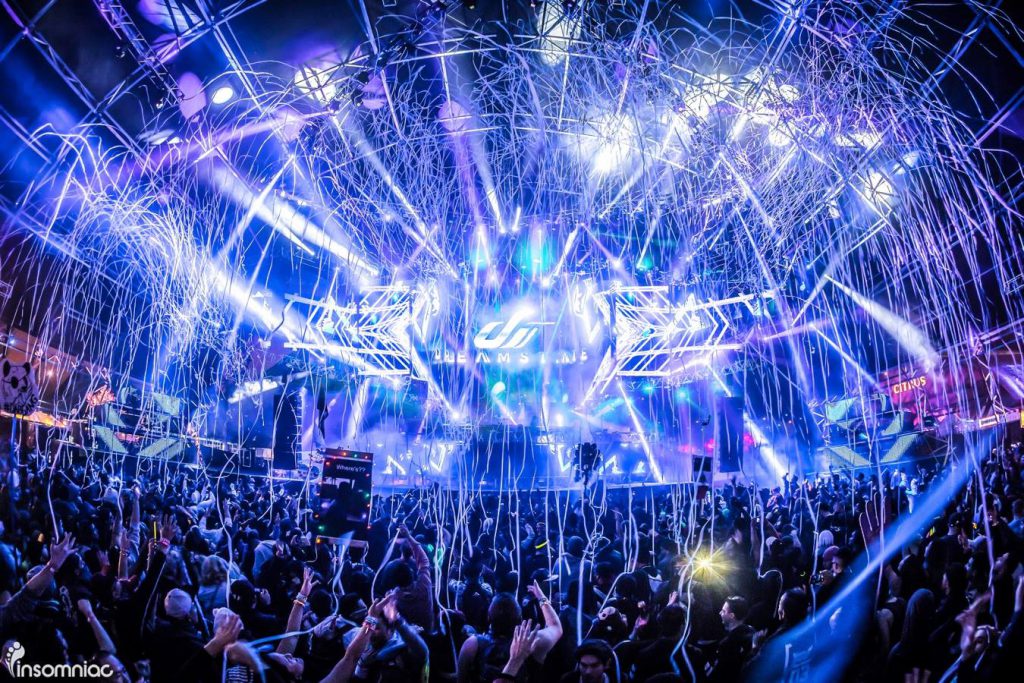
Photo Credit: Insomniac Events
Closing Comments
Festivals are, for the most part, an audio and visual experience. It is why you pay the big admission fee. You want to be impressed by an amazing sound system, crazy lasers and lights setups, and superb audio choreography. You also hope that the music, the element that remains the most important one, is to your liking. Having witness two prior Dreamstate events, I felt a bit cheated by the production quality of Insomniac’s latest offering. Sound issues that plagued multiple stages and visual setups that felt two grades below what was offered in the past were a constant disturbance.
However, the music that I’ve heard was by far the best! I was able to listen to mainly classics or productions that are inspired by the original intent of the genre. For someone that grew up with that sound and not being able to attend shows in the 1990s and early 2000s, this was simply perfect.
Follow Dreamstate SoCal on social media:
Featured Photo Credit: Insomniac Events



